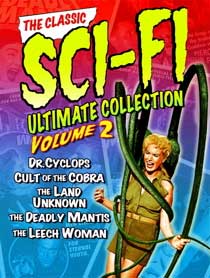 THE
CLASSIC SCI-FI ULTIMATE COLLECTION, VOLUME 2 (1940-1960)
THE
CLASSIC SCI-FI ULTIMATE COLLECTION, VOLUME 2 (1940-1960)Directors: Ernest Schoedsack, Francis D. Lyon, Virgil Vogel, Nathan Juran, Edward Dein
Universal
 THE
CLASSIC SCI-FI ULTIMATE COLLECTION, VOLUME 2 (1940-1960)
THE
CLASSIC SCI-FI ULTIMATE COLLECTION, VOLUME 2 (1940-1960)September 2007 has become an overwhelming month of cult DVD releases, perhaps the largest amount of genre titles to be released on one day (9/11, more than 15 releases, over 30 different titles!). This set may be the most overlooked, due to being an exclusive release to Best Buy. A follow-up to last Fall’s first volume of Universal sci-fi films, this three-DVD edition features five titles that range from classic themes of giant monsters run amok to obsessed scientists out of control. All of the movies are cult classics that are worth the effort to pick up in this affordable set ($19.99). Bear in mind, this is also a limited released, likely to only be on shelves for a few months, assuming supplies last (if you’re hesitant to get this now, take a look at what the first goes for on eBay).
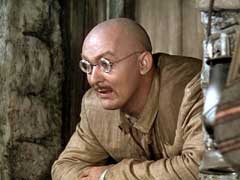
DR. CYCLOPS (1940, color), directed by Ernest Schoedsack (KING KONG) stars Albert Dekker (Later of THE KILLERS and THE WILD BUNCH) as Dr. Thorkel, a renowned scientist in the jungles of South America who invites three brilliant scientists to help verify the results of his mysterious experiments. After they arrive, they are met by the seemingly gracious and kind doctor, only to be dismissed after quickly giving the confirmations Thorkel required of them. Soon, they find themselves shrunk down to the size of a Barbie doll by the crazed scientist and having to find a way to escape and return to normal height, battling the new land of giants around them in the meantime. The actors also featured in this include Janice Logan, Thomas Coley, Charles Halton, Victor Killian and Frank Yaconelli.
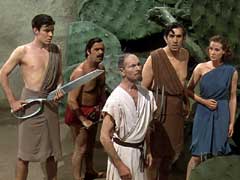 The
film is notable for being the first science fiction film made using three-color
Technicolor, and the transfer is outstanding! The print source used is amazingly
clean, free of dirt and scratches. Universal ought to be praised for helping
this film show up on DVD in such a respectable way. The clarity and detail of
every shot is incredible, and I was surprised when reminded it was originally
released in 1940! I would surmise that the transfer was done in high-definition,
due to the amount of detail and lack of artifacts (not to mention the intensity
of the colors throughout the film). The special effects are stunning, deceptively
creative and effective. I would go as far to say that the Schoedsack’s
use of miniatures and early green-screen/rear-projection should be studied by
more filmmakers – you will find yourself easily believing that these shrunken
people really are trying to escape from a giant! Only once or twice did I notice
significant fuzziness of the visual effects in scenes with Dr. Thorkel in pursuit
of the victims.
The
film is notable for being the first science fiction film made using three-color
Technicolor, and the transfer is outstanding! The print source used is amazingly
clean, free of dirt and scratches. Universal ought to be praised for helping
this film show up on DVD in such a respectable way. The clarity and detail of
every shot is incredible, and I was surprised when reminded it was originally
released in 1940! I would surmise that the transfer was done in high-definition,
due to the amount of detail and lack of artifacts (not to mention the intensity
of the colors throughout the film). The special effects are stunning, deceptively
creative and effective. I would go as far to say that the Schoedsack’s
use of miniatures and early green-screen/rear-projection should be studied by
more filmmakers – you will find yourself easily believing that these shrunken
people really are trying to escape from a giant! Only once or twice did I notice
significant fuzziness of the visual effects in scenes with Dr. Thorkel in pursuit
of the victims.
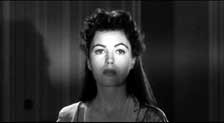 CULT
OF THE COBRA (1955, b&w), directed by Francis D. Lyon (editor, Curt Siodmak’s
BRIDE OF THE GORILLA), tells the story of six G.I.’s stationed in Asia who
manage to sneak into the ceremony of the Lamians, a cult of that worships women
that can change into serpents. After giving themselves away, one soldier is bitten
by a snake and is taken to a hospital. While admitted and appearing to recover
from the poisonous bite, the soldier winds up dead the following morning from
a sudden mysterious increase in venom surging through his system. The soldiers
are then sent back home to the US, having to readjust to civilian life after the
death of a friend. Soon, a new neighbor (Faith Domergue, THIS ISLAND EARTH) to
one soldier wiggles her way into their lives, while at the same time the officers
begin to have their ranks strangely killed. The film also features Richard Long,
Marshall Thompson, David Janssen, Kathleen Hughes, William Reynolds, Jack Kelly,
and Myrna Hansen.
CULT
OF THE COBRA (1955, b&w), directed by Francis D. Lyon (editor, Curt Siodmak’s
BRIDE OF THE GORILLA), tells the story of six G.I.’s stationed in Asia who
manage to sneak into the ceremony of the Lamians, a cult of that worships women
that can change into serpents. After giving themselves away, one soldier is bitten
by a snake and is taken to a hospital. While admitted and appearing to recover
from the poisonous bite, the soldier winds up dead the following morning from
a sudden mysterious increase in venom surging through his system. The soldiers
are then sent back home to the US, having to readjust to civilian life after the
death of a friend. Soon, a new neighbor (Faith Domergue, THIS ISLAND EARTH) to
one soldier wiggles her way into their lives, while at the same time the officers
begin to have their ranks strangely killed. The film also features Richard Long,
Marshall Thompson, David Janssen, Kathleen Hughes, William Reynolds, Jack Kelly,
and Myrna Hansen.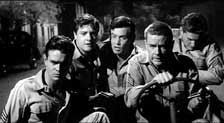 CULT
starts out like an Army-buddy film buts turns to a mystery of death and a bizarre
myth of shape-changing women that may actually be true. Lyon does a great job
of using shadows to show the impending fates of the soldiers, instead of revealing
a poor special effect. This easily could have turned out to be one of the lesser
films in the set, but I found it to be the one of the most enjoyable. More of
a horror/suspense film that is more like a lower-rent Val Lewton film, CULT OF
THE COBRA is highly recommended.
CULT
starts out like an Army-buddy film buts turns to a mystery of death and a bizarre
myth of shape-changing women that may actually be true. Lyon does a great job
of using shadows to show the impending fates of the soldiers, instead of revealing
a poor special effect. This easily could have turned out to be one of the lesser
films in the set, but I found it to be the one of the most enjoyable. More of
a horror/suspense film that is more like a lower-rent Val Lewton film, CULT OF
THE COBRA is highly recommended. The
1.85:1 anamorphic transfer of this feature is also very well done, though not
as bold as DR. CYCLOPS – however, this is totally acceptable since this
movie was not meant to be as visually outrageous as the fore-mentioned film. The
film shows little grain and strong contrast between the blacks and whites, again
leading me to believe this was transferred in high-definition. A very well done
presentation!
The
1.85:1 anamorphic transfer of this feature is also very well done, though not
as bold as DR. CYCLOPS – however, this is totally acceptable since this
movie was not meant to be as visually outrageous as the fore-mentioned film. The
film shows little grain and strong contrast between the blacks and whites, again
leading me to believe this was transferred in high-definition. A very well done
presentation!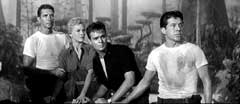 THE
LAND UNKNOWN (1957, b&w), directed by Virgil Vogel (THE MOLE PEOPLE; editor
of TOUCH OF EVIL and THIS ISLAND EARTH), stars Jock Mahoney as the Commander in
charge of an expedition to Antarctica. Tagging along is a news reporter (played
by Shawn Smith, aka Shirley Patterson), who along with the Commander and two other
sailors find themselves having to make an emergency landing while lost in an impending
storm (not to mention the attack by a pterodactyl). They set down 3000 meters
below sea level in what appears to be a lost jungle among the Artic. The group
finds they are trapped there with the helicopter damaged and little chance of
successful communication with the rest of the expedition. As if that isn’t
enough, they are soon chased by giant lizards, man-eating plants, a hungry tyrannosaurus
rex and what might be a long-lost primitive man (or monster)! The film also stars
William Reynolds, Phil Harvey, Douglas Kennedy, and most importantly, Henry Brandon
as the would-be caveman villain (perhaps the actor is better known from MARCH
OF THE WOODEN SOLDIERS, THE SEARCHERS and later of ASSAULT ON PRECINCT 13).
THE
LAND UNKNOWN (1957, b&w), directed by Virgil Vogel (THE MOLE PEOPLE; editor
of TOUCH OF EVIL and THIS ISLAND EARTH), stars Jock Mahoney as the Commander in
charge of an expedition to Antarctica. Tagging along is a news reporter (played
by Shawn Smith, aka Shirley Patterson), who along with the Commander and two other
sailors find themselves having to make an emergency landing while lost in an impending
storm (not to mention the attack by a pterodactyl). They set down 3000 meters
below sea level in what appears to be a lost jungle among the Artic. The group
finds they are trapped there with the helicopter damaged and little chance of
successful communication with the rest of the expedition. As if that isn’t
enough, they are soon chased by giant lizards, man-eating plants, a hungry tyrannosaurus
rex and what might be a long-lost primitive man (or monster)! The film also stars
William Reynolds, Phil Harvey, Douglas Kennedy, and most importantly, Henry Brandon
as the would-be caveman villain (perhaps the actor is better known from MARCH
OF THE WOODEN SOLDIERS, THE SEARCHERS and later of ASSAULT ON PRECINCT 13).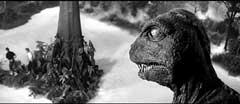 Presented
in 2.35:1 anamorphic widescreen, THE LAND UNKNOWN features another stunning transfer,
likely in high-definition. Some may find the movie to be cheesy due to the silly
SPFX, such as the classic footage of real reptiles intended to be dinosaurs and
the man-in-a-suit as the T-Rex. But I found the effects to actually be admirable
and fun. Given a closer look, viewers will notice that the filmmakers did their
best with their abilities and money (just look at the details given to the T-Rex’s
blinking eyes). The sets make the movie, though – the classy transfer and
widescreen presentation show how much effort went into this film. Go with it and
suspend your disbelief, and you may find this more enjoyable than a certain 1990s
series of dinosaur movies.
Presented
in 2.35:1 anamorphic widescreen, THE LAND UNKNOWN features another stunning transfer,
likely in high-definition. Some may find the movie to be cheesy due to the silly
SPFX, such as the classic footage of real reptiles intended to be dinosaurs and
the man-in-a-suit as the T-Rex. But I found the effects to actually be admirable
and fun. Given a closer look, viewers will notice that the filmmakers did their
best with their abilities and money (just look at the details given to the T-Rex’s
blinking eyes). The sets make the movie, though – the classy transfer and
widescreen presentation show how much effort went into this film. Go with it and
suspend your disbelief, and you may find this more enjoyable than a certain 1990s
series of dinosaur movies.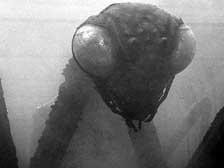 THE
DEADLY MANTIS (1957, b&w), directed by Nathan Juran (director of many sci-fi
classics, i.e. ATTACK OF THE 50 FT WOMAN, 20 MILLION MILES TO EARTH, and one of
my faves, THE BRAIN FROM PLANET AROUS), is the classic story of nature getting
revenge against man and science. Upon awakening from an iceberg, a giant praying
mantis decides to attack anyone in its path to New York. Fighting it along the
way is Craig Stevens, Alex Talton, and William Hopper.
THE
DEADLY MANTIS (1957, b&w), directed by Nathan Juran (director of many sci-fi
classics, i.e. ATTACK OF THE 50 FT WOMAN, 20 MILLION MILES TO EARTH, and one of
my faves, THE BRAIN FROM PLANET AROUS), is the classic story of nature getting
revenge against man and science. Upon awakening from an iceberg, a giant praying
mantis decides to attack anyone in its path to New York. Fighting it along the
way is Craig Stevens, Alex Talton, and William Hopper.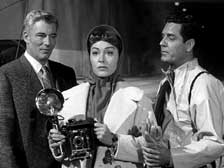 Considered
to be a classic of the giant monster movies of the 1950s, I found this to be one
of the lesser films in the context of this set. However, this should not dissuade
anyone from purchasing the set – this is only the reviewer’s opinion.
A bit slow moving, but worth the journey once the mantis attacks the army bases
and New York. Featuring a giant insect that flies instead of simply crushing anything
in its path to civilization, THE DEADLY MANTIS does make good use of green-screen
SPFX, miniatures and large-scale beasts.
Considered
to be a classic of the giant monster movies of the 1950s, I found this to be one
of the lesser films in the context of this set. However, this should not dissuade
anyone from purchasing the set – this is only the reviewer’s opinion.
A bit slow moving, but worth the journey once the mantis attacks the army bases
and New York. Featuring a giant insect that flies instead of simply crushing anything
in its path to civilization, THE DEADLY MANTIS does make good use of green-screen
SPFX, miniatures and large-scale beasts.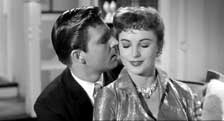 THE
LEECH WOMAN (1960, b&w) directed by Edward Dein (co-writer of THE LEOPARD
MAN), is a morality play in the guise of a mad scientist horror film. The movie
stars Colleen Gray as an aging, alcoholic woman trapped in an unhappy marriage
with scientist Phillip Terry, an abusive bully that enjoys tormenting his wife.
While looking for a cure to aging, the scientist finds a possible remedy from
an odd woman that claims be more than 140 years old and originally from a small
tribe in Africa. She promises to take the scientist to the cure in exchange for
the money to return home to die; of course, nothing is as it seems and the unlikable
protagonists find themselves trapped by the tribe and death. Once in Africa, the
couple hires an adventurer to lead them to the tribe and find the mysterious old
woman. The three are shown the secret ritual once they are captured by the tribe
of the old woman – unfortunately, it involves the sacrifice of a man. Once
shown that the cure is real, the scientist gives over his wife to allow him to
steal the cure and profit off of it. This greed, of course, leads to a disastrous
escape with only Gray surviving with the ability to stay young. Her return home
brings death and lust with those close to her.
THE
LEECH WOMAN (1960, b&w) directed by Edward Dein (co-writer of THE LEOPARD
MAN), is a morality play in the guise of a mad scientist horror film. The movie
stars Colleen Gray as an aging, alcoholic woman trapped in an unhappy marriage
with scientist Phillip Terry, an abusive bully that enjoys tormenting his wife.
While looking for a cure to aging, the scientist finds a possible remedy from
an odd woman that claims be more than 140 years old and originally from a small
tribe in Africa. She promises to take the scientist to the cure in exchange for
the money to return home to die; of course, nothing is as it seems and the unlikable
protagonists find themselves trapped by the tribe and death. Once in Africa, the
couple hires an adventurer to lead them to the tribe and find the mysterious old
woman. The three are shown the secret ritual once they are captured by the tribe
of the old woman – unfortunately, it involves the sacrifice of a man. Once
shown that the cure is real, the scientist gives over his wife to allow him to
steal the cure and profit off of it. This greed, of course, leads to a disastrous
escape with only Gray surviving with the ability to stay young. Her return home
brings death and lust with those close to her.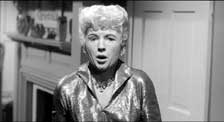 Arranged
in three acts, this melodramatic movie is the least of the set. The acts are unbalanced
and would have benefited from shifting the amount of time given to the introductory
act (showing the poor relationship between the scientist and his wife) to the
final act (the return of Gray to the U.S. and the rampage she goes on to maintain
her youth). The middle is also plodding, but eventually leads to the meat of the
story and the eventual but hurried climax and ending. Only one character is truly
worth rooting for, being the adventurer played by John Van Dreelen. The film is
probably most notable for having Grant Williams and Gloria Talbott as supporting
players, and an African-American main character (in the role of the old woman).
Arranged
in three acts, this melodramatic movie is the least of the set. The acts are unbalanced
and would have benefited from shifting the amount of time given to the introductory
act (showing the poor relationship between the scientist and his wife) to the
final act (the return of Gray to the U.S. and the rampage she goes on to maintain
her youth). The middle is also plodding, but eventually leads to the meat of the
story and the eventual but hurried climax and ending. Only one character is truly
worth rooting for, being the adventurer played by John Van Dreelen. The film is
probably most notable for having Grant Williams and Gloria Talbott as supporting
players, and an African-American main character (in the role of the old woman).
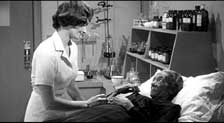 THE
LEECH WOMAN is presented in a rather nice 1.85:1 anamorphic transfer, showing
good contrast between the black and white elements of the film. A drawback is
that the film is not highly stylized, but rather plain and lacking in creativity.
All titles in this set feature their original trailers and contain clean, satisfactory
mono audio tracks in English only.
THE
LEECH WOMAN is presented in a rather nice 1.85:1 anamorphic transfer, showing
good contrast between the black and white elements of the film. A drawback is
that the film is not highly stylized, but rather plain and lacking in creativity.
All titles in this set feature their original trailers and contain clean, satisfactory
mono audio tracks in English only.
Overall, THE CLASSIC SCI-FI ULTIMATE COLLECTION, VOLUME 2 is highly recommended
for fans of stereotypical science fiction movies from the days when SPFX were
handmade and the suspension of disbelief was required by film fans. It features
at least three true classics and may help restore some of the films to a higher
status among other more highly regarded films. Universal should be commended
for putting these collections together, with the only regret being that these
sets are not available elsewhere or individually. Otherwise, thank you, Universal
and Best Buy. (Ben Gart)